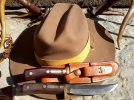G'day Carspidey
Now that I have the semantics about the "origin of the term bushcraft out of my system", some
personal thoughts about your original question

.
Please bear in mind right at the start, that my opinions are different to what most folks these days would describe as "Bushcraft", and I acknowledge that this post will put a bullseye on my forehead

.
IMO, a knife that is suitable for
genuine bushcraft needs to do more that cut wood.
It also needs to be able to process any animal taken to provide meat for the table.
Have a look at what is currently taken as "the look of a bushcraft knife", ala the woodlore & various clones.
Do you reckon these are the best design for skinning & processing game?
In my experience they are not.
Any design that appears to optimise it's performance with wood tells me that the designer really doesn't know what
genuine bushcraft is about.
IMO, look for a design that is usefull for processing animals as well as wood. This is a knife that is designed by someone that knows what bushcraft is, rather than someone that is merely following what they think the majority think it is.
Comfort in hand during extended use is another important aspect, as is edge holding.
IMO forget the often repeated BS about the only steel suitable is carbon steels, i.e. non stainless steels. IMO, these people repeatedly show they have no experience with some of the modern stainless steels on offer :thumbup:
To finish off, please bear in mind this is one persons opinion

Kind regards
Mick



